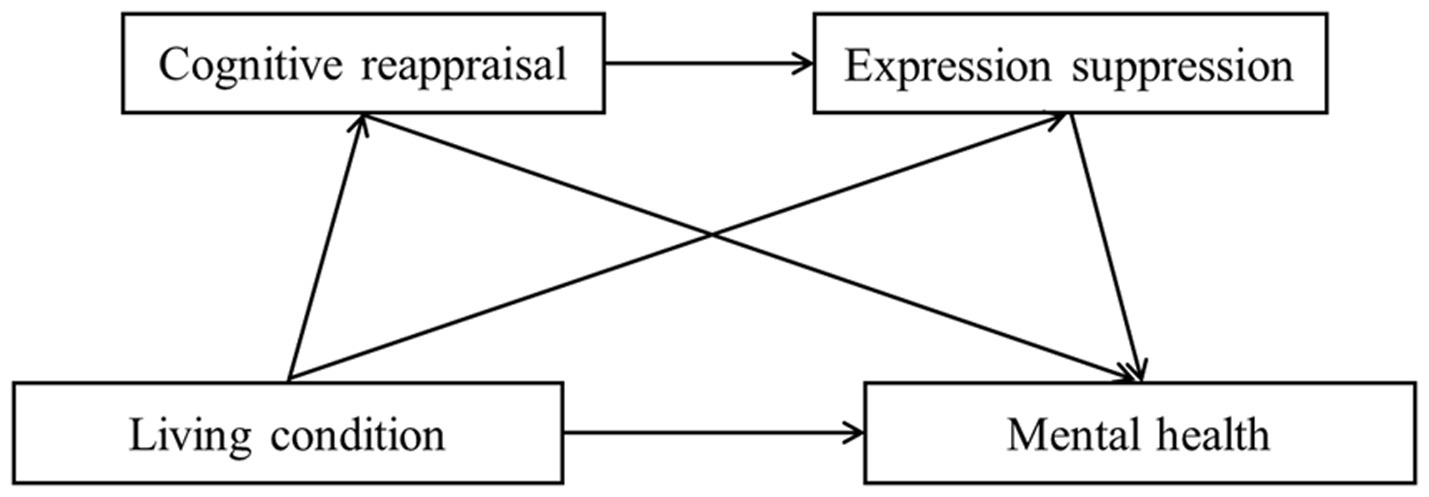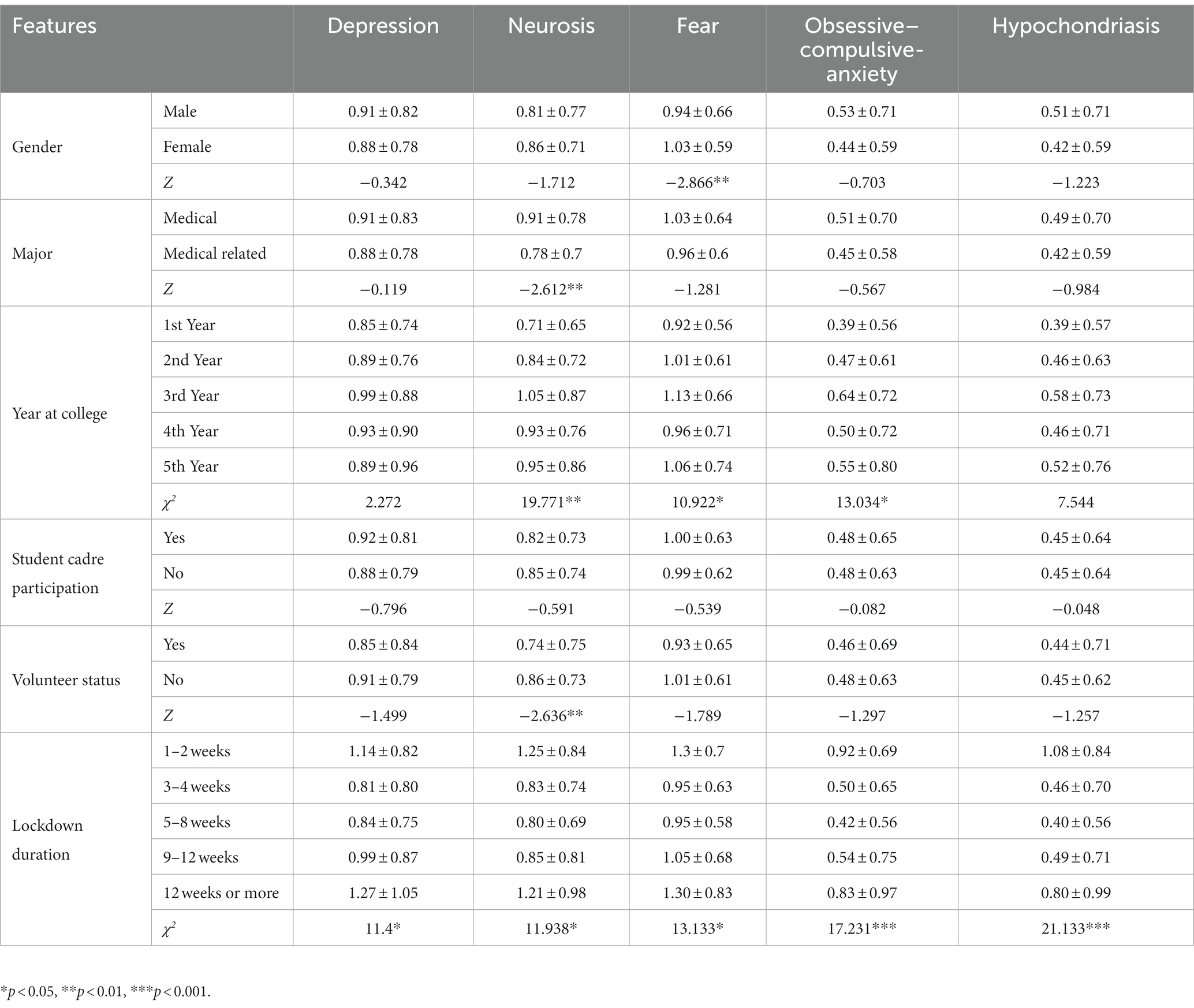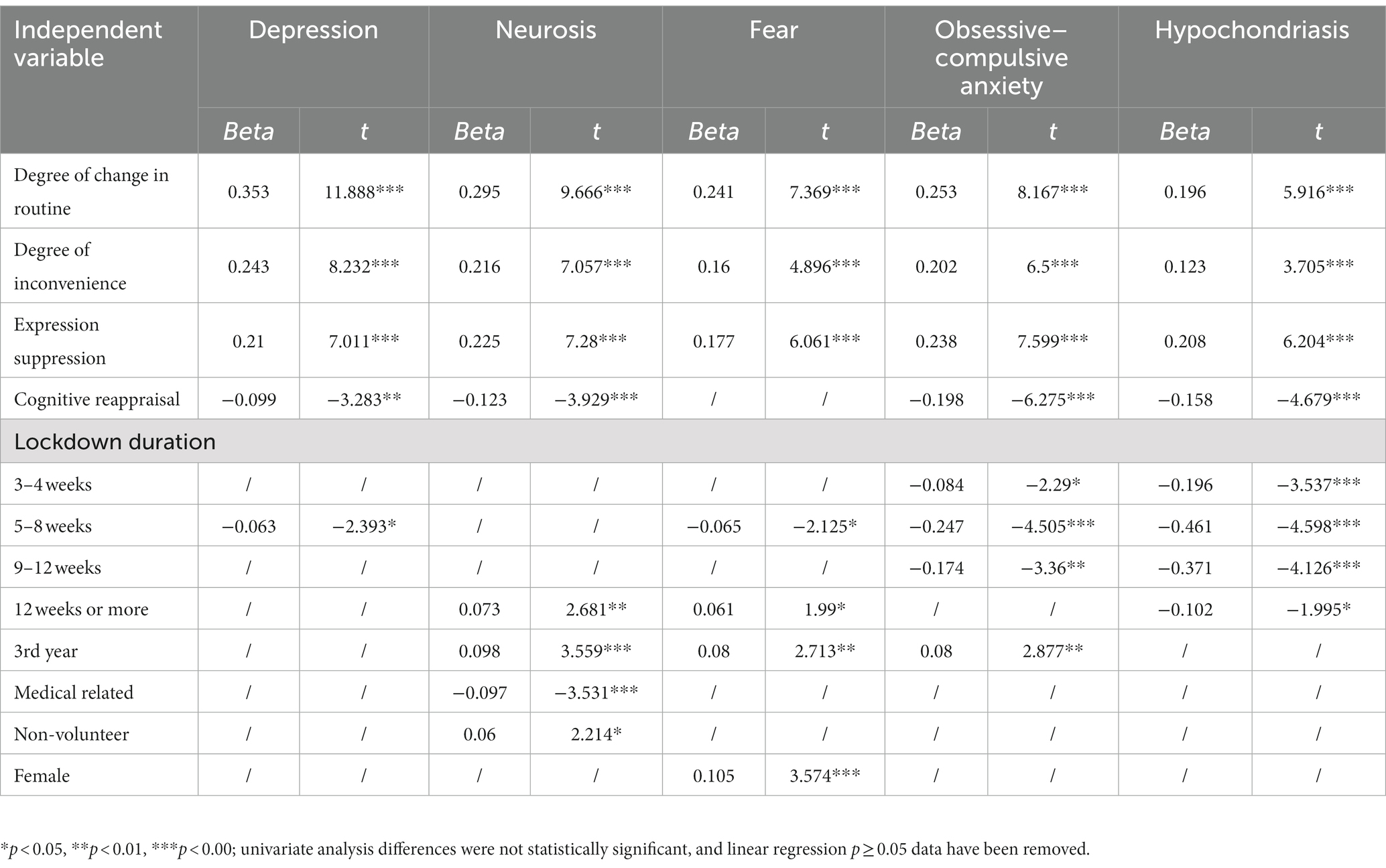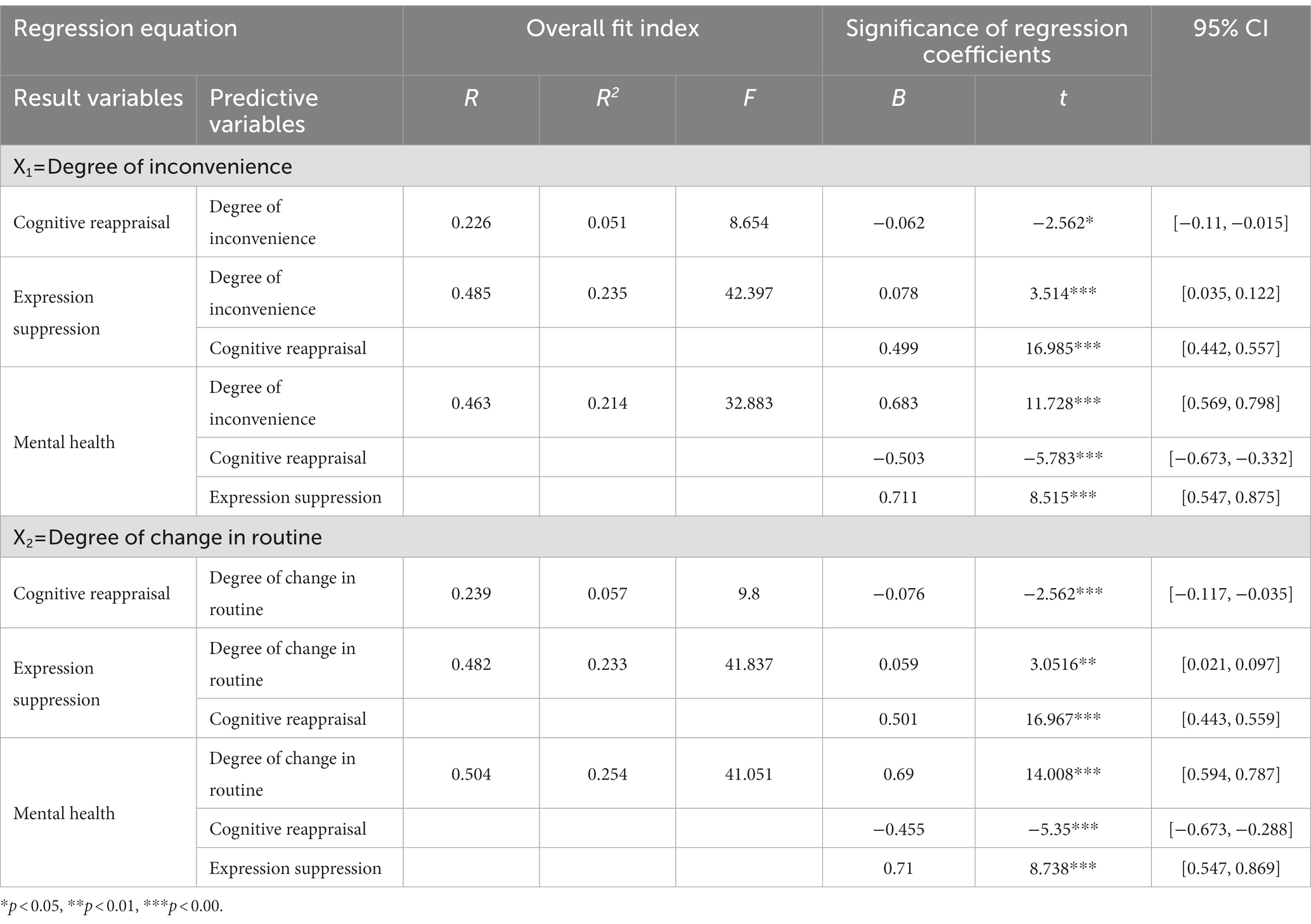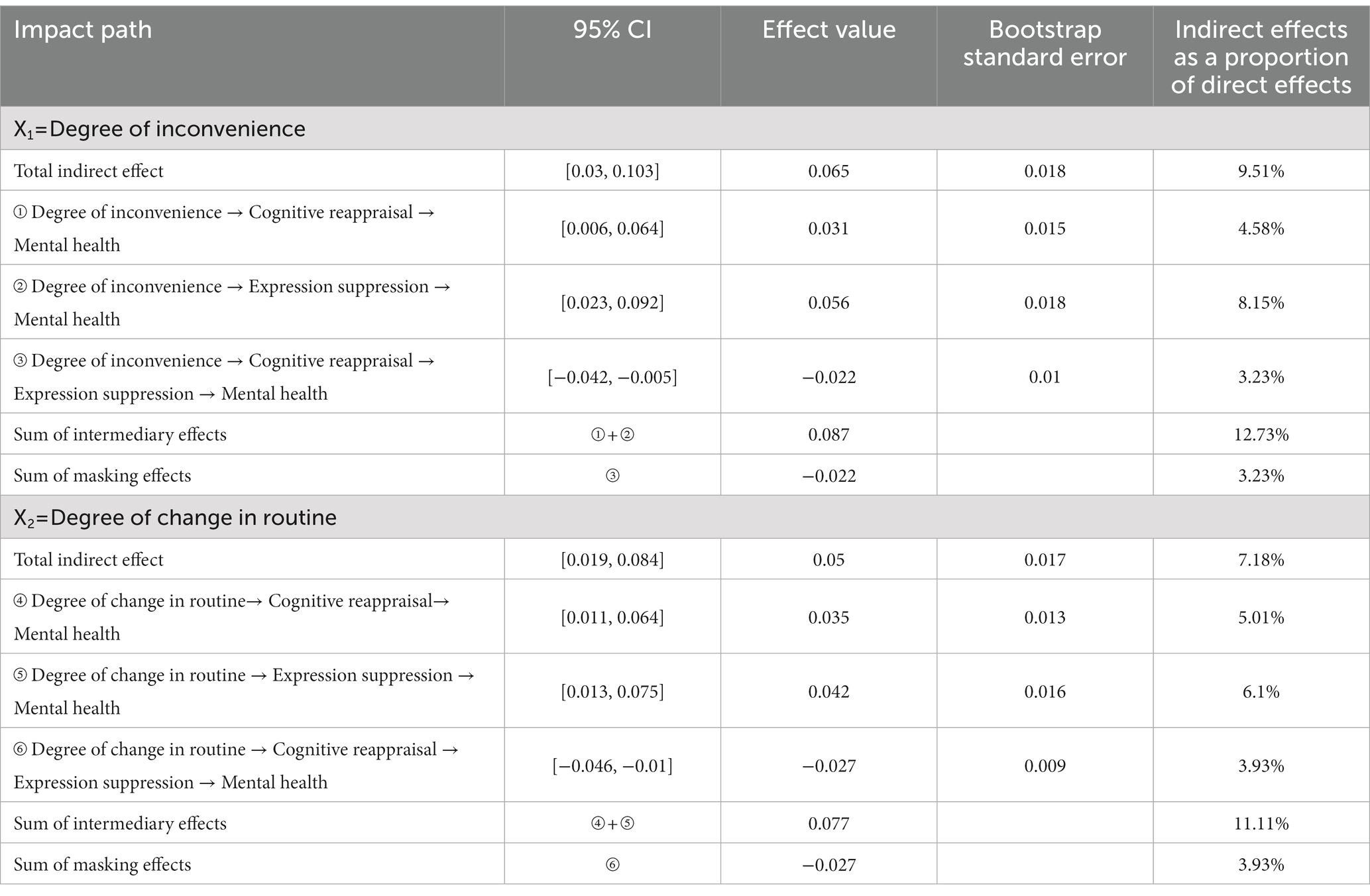- 1School of Marxism, Wannan Medical College, Wuhu, China
- 2School of Humanities and Management, Wannan Medical College, Wuhu, China
- 3Anhui Key Laboratory of Philosophy and Social Sciences for Public Health Crisis Management, Wuhu, China
Objective: To investigate the effect of changes in campus living conditions related to the Corona Virus Disease 2019 (COVID-19) pandemic on medical school students’ mental health status, to explore the mediating role of emotion regulation strategies, and to provide effective suggestions for promoting medical school students’ mental health.
Methods: A self-report questionnaire, an emotion regulation questionnaire (ERQ), and psychological questionnaires for emergent events of public health (PQEEPH) were used to interview 998 medical school students who experienced campus lockdowns during the COVID-19 pandemic.
Results: The mean total PQEEPH score was 3.66 ± 3.06. The degrees of inconvenience in daily life and change in routine and expression suppression as an emotion regulation strategy were significantly positively correlated with all PQEEPH dimensions. Cognitive reappraisal was significantly negatively associated with depression, neurosis, obsessive–compulsive anxiety, and hypochondriasis (ps < 0.05). Cognitive reappraisal and expression suppression demonstrated a chain mediating role between the degree of inconvenience in life and mental health and between the degree of change in routine and mental health (F = 32.883, 41.051, ps < 0.05).
Conclusion: Campus lockdown management significantly impacts medical school students’ mental health. Extensive use of cognitive reappraisal and expression suppression can reduce students’ adverse psychological reactions during campus lockdowns to an extent.
1. Introduction
Since 2020, the novel SARS-CoV-2 has caused a rapidly expanding, life-threatening pandemic (the COVID-19 pandemic) (1). Most schools worldwide were closed and students had to complete courses delivered entirely remotely to prevent the spread of the pandemic in the spring semester of 2020 (2). Most students have returned to school attending classes (either online or offline) following necessary public health precautions since the fall semester of 2020. These precautions have been called the “new normal” in the US and “regular measures implemented to control epidemic” in China (3, 4). Because of the continuing mutation, shorter incubation period, and higher rates of asymptomatic infection, the pandemic situation became more pressing in the first half of 2022, and some colleges and universities in China had to adopt a 1–3-month campus lockdown policy (or “static management”) in response to local COVID-19 outbreaks (5). Accordingly, to cope with this situation, different degrees of campus lockdown measures were adopted to set clear boundaries between areas on and off campus and separate internal and external personnel (6). Furthermore, colleges and universities had implemented various degrees of pandemic prevention and control measures, including strict access management; strict student, faculty, and staff management; online study and examinations; dine-in option banishment; closure of public places on campus; campus-wide nucleic acid amplification tests; and dormitory quarantine with necessities delivered by volunteers (7–11).
Research has found that the length of closure, isolated living conditions, health habits, physical exercise, and sleep conditions had an important impact on people’s mental health during the pandemic lockdown, and that occupation, age, gender, and cultural background were also significant factors (12–16). However, campus lockdown management was not handled in the same way as general social lockdown management. The aforementioned studies placed more emphasis on the evaluation of objective factors in the lockdown, while the quantification of campus life and management factors was inadequate. As research on the impact of these subjective experiences on mental health is not sufficient, it is difficult to propose effective response measures and improvement suggestions for campus lockdown management.
The pandemic and prolonged campus lockdown have changed the campus routine, reduced the convenience of campus life, and adversely affected college students’ work and leisure (17), resulting in social isolation, loneliness, and relative deprivation (18, 19). Furthermore, these factors may have caused psychological stress, leading to negative emotions such as depression, neurosis, obsessive–compulsive anxiety, fear, and hypochondriasis (20–23). This means that the greater the inconveniences to one’s life and the higher the change in routine, the stronger the psychological reaction and the lower the level of psychological health. Consequently, we proposed the following hypothesis:
Hypothesis 1: Campus living conditions would positively predict medical school students’ psychological responses.
Emotion regulation is the management of people’s emotions, including when and how they express and experience them (24). Cognitive reappraisal is an adaptive emotion regulation strategy that helps to enhance the positive emotional experience of individuals and weaken their negative emotional experience. Meanwhile, expression suppression is a non-adaptive emotion regulation strategy and is more likely to induce various psychological disorders. The appropriate use of emotion regulation strategies can effectively regulate an individual’s mental health status before and after the onset of emotions (25, 26). Neurologists have further corroborated the mode of action of different emotion regulation strategies through functional MRI, potential recognition, and more (27, 28). Emotion regulation strategies have been applied in neurological disorders treatment, time perception, and psychological support and interventions (29–31). Studies have shown that cognitive reappraisal is beneficial in relieving emotions such as anxiety and depression, while expression suppression has the opposite effect (32–34). Consequently, we proposed the following two hypotheses:
Hypothesis 2: Cognitive reappraisal would negatively predict medical school students’ psychological responses.
Hypothesis 3: Expression suppression would positively predict medical school students’ psychological responses.
Emotional regulation strategies act as an interactive process between medical school students, school, and the development of the pandemic. They are not only strategies that medical school students have acquired during adolescence, but also post-educational and managerial processes developed during university study (26). Thus, emotional regulation strategies acquired and developed during the pandemic may be important for the future emotional management of students’ life and work. Different methods of campus closure management may lead to different emotional regulation strategies, which, in turn, may lead to different psychological experiences. Therefore, emotional regulation strategies may play a mediating role between campus lockdown and mental health, considering the sequential order of the two strategies (i.e., cognitive reappraisal and expression suppression) and their intrinsic connection with one another. Consequently, we proposed the following hypothesis:
Hypothesis 4: Emotional regulation strategies could play a mediating role between campus living conditions and mental health.
Therefore, this study analyzed the main factors and modes of action affecting medical school students’ mental health based on an investigation of their living conditions, emotion regulation strategies, and psychological reactions during campus lockdowns. This research can provide data to support universities in strengthening students’ mental health education, improving management services, and optimizing the path of medical talent training during the pandemic. Considering that cognitive reappraisal and expression suppression modulate an individual’s mental health before and after such emotions occur (25), the hypothetical model of the relationship between related variables is shown in Figure 1.
2. Methods
2.1. Participants and design
An anonymous survey was conducted from April to May 2022, which was the period of the campus lockdown included in this study during the COVID-19 pandemic. Students at a medical school were recruited from 11 departments via stratified random sampling. Thus, 10% (998) of the students on campus (about 10,000 students in total) were randomly selected according to grade stratification. Before the survey, all participants were briefed on the purpose, process, and privacy of the study by their tutors through online video conference and were required to answer the questions via the online questionnaire to facilitate data statistics and ensure that they meet the pandemic prevention requirements. The inclusion criteria were medical school students who experienced a campus lockdown for 1 week or longer and completed 80% or more of the questionnaire. A total of 998 college students were surveyed, and questionnaires that did not meet the internal consistency check requirements (n = 24) were excluded. Ultimately, 974 valid questionnaires were returned (total effective rate: 97.6%), of which 373 (38.3%) participants were men and 601 (61.7%) were women; 423 (43.4%) participants were 5-year medical majors, such as clinical medicine, dentistry, anesthesiology, forensic medicine, medical imaging, which means they will receive a medical degree after 5 years of study; and 551 (56.6%) were 4-year medical-related majors, such as nursing, pharmacy, medical testing, medical information, medical law and public health management, which means they have taken medical courses and will mostly work in hospitals or health facilities after graduation. The surveyed students were from one medical college of Anhui Province with an average age of 20.07 ± 1.76 years. After completing the questionnaire, the students were compensated with rewards or equivalent gifts for participating in the study. This study was performed in accordance with the ethical principles of the Declaration of Helsinki. The Medical Ethics Committee of Wannan Medical College approved this study and the format of the participant consent form (Approved No. 2022-102).
2.2. Measures
2.2.1. Self-report questionnaire
A self-report questionnaire was used to collect participants’ basic demographic data and life situation information during the campus lockdown, including objective information such as “length of time under campus lockdown” and whether they “served as a volunteer supporting nucleic acid amplification tests,” and information on subjective experiences, such as “intensity of self-prevention,” “degree of inconvenience,” and “degree of change in routine.” The intensity of self-prevention was calculated based on the prevention and control measures noted in sources such as the “Prevention and Control Plan for Novel Coronavirus Pneumonia (8th Edition)” (35) and “Citizens’ Knowledge Manual for New Coronavirus Prevention” Version 2.0 (e.g., not leaving the dormitory or home, daily temperature measurement and health monitoring, nucleic acid amplification testing at least three times a week, daily window ventilation or disinfection, individual dining or no dine-in, and online work or study). Each effect was attributed one point, and total scores ranged from 0 to 8 points (“0” indicates “the least self-prevention,” and “8” signifies “the strictest self-prevention”). The degree of inconvenience in daily life was calculated based on Xie et al. (36) and included seven points (e.g., inconvenience in transportation, difficulty in accessing medical care, discomfort of being away from the crowd, and other aspects that require additional explanation). Each effect was attributed one point; thus, the total score ranged from 0 = “as convenient as before” to 7 = “extremely inconvenient.” For the degree of change in routine, participants used a scale ranging from 1 to 7 (from “not affected at all” to “completely affected”) to rate the degree to which their daily schedule was affected by the campus lockdown. This survey’s internal consistency coefficient was 0.609.
2.2.2. Emotion regulation questionnaire
The Emotion Regulation Questionnaire (ERQ) (37) comprises 10 items and two dimensions: cognitive reappraisal and expression suppression. The participants rated their responses regarding situational emotion regulation strategies on a scale ranging from 1 = “completely disagree” to 7 = “completely agree.” The higher the mean score on the dimensions, the more participants were accustomed to using the emotion regulation strategy. In this study, the internal consistency coefficients for cognitive reappraisal and expression suppression were 0.934 and 0.852, respectively.
2.2.3. Psychological questionnaires for emergent events of public health
The Psychological Questionnaires for Emergent Events of Public Health (PQEEPH) was developed by Chinese experts after the SARS pandemic in 2003. In addition, it was confirmed as applicable to the COVID-19 pandemic (38). The premise was set as “possible psychological reactions to the COVID-19 pandemic” to fit the actual situation of the study. The questionnaire comprises 25 items with five dimensions: depression, neurosis, fear, obsessive–compulsive anxiety, and hypochondriasis. The participants rated their responses to situational psychological reactions on a scale from 0 = “never” to 3 = “always.” Higher scores were associated with stronger psychological reactions. In this study, the internal consistency coefficients of the five dimensions were 0.928, 0.890, 0.792, 0.891, and 0.774, respectively.
2.3. Statistical analysis
SPSS Version 22.0 (IBM Corp., Armonk, NY, United States) was used to perform statistical analysis. In addition, the measurement data were expressed as “x ± s,” and the Wilcoxon rank sum test was used to compare differences between two groups (test value Z), the Kruskal–Wallis test was used to examine the differences between multiple groups (test valueχ2), Spearman’s correlation analysis was used for each scale item and psychological response, and multiple linear stepwise regression analysis was performed for those with significance. The bootstrap method proposed by Preacher and Hayes (39) and Model 6 in the PROCESS macro program written by Hayes1 (40) were used to test the specific chain mediating effect. A test level of α = 0.05 and p < 0.05 was considered statistically significant.
3. Results
3.1. Common method bias
Harman’s single-factor test (41) was used to avoid common method bias in the self-report questionnaire, and the first common factor explained 36.87% of the variance. This result was less than the critical value of 40%, indicating that common method bias was not a serious issue in this study.
3.2. Descriptive statistics
3.2.1. Descriptive statistics for living condition and emotion regulation strategies
Of the survey respondents, 658 (67.6%) reported being under campus lockdown management for up to 5–8 weeks, and 209 (21.5%) served as volunteers during campus lockdowns. Univariate analysis showed statistically significant differences in “intensity of self-prevention” based on whether participants were student cadres and volunteers (Z = −3.247, −2.646, ps < 0.05), “degree of inconvenience” based on year at college and whether they were student cadres (Z/χ2 = 26.18, −3.289, ps < 0.05), and “degree of change in routine” based on gender (Z = −2.831, p < 0.05). Cognitive reappraisal scores differed statistically based on gender, major, whether they were student cadres, and whether they were volunteers (Z = −5.553, −2.326, −2.568, −2.305, ps < 0.05). No significant differences were found in expression suppression based on respondents’ general characteristics (Table 1).
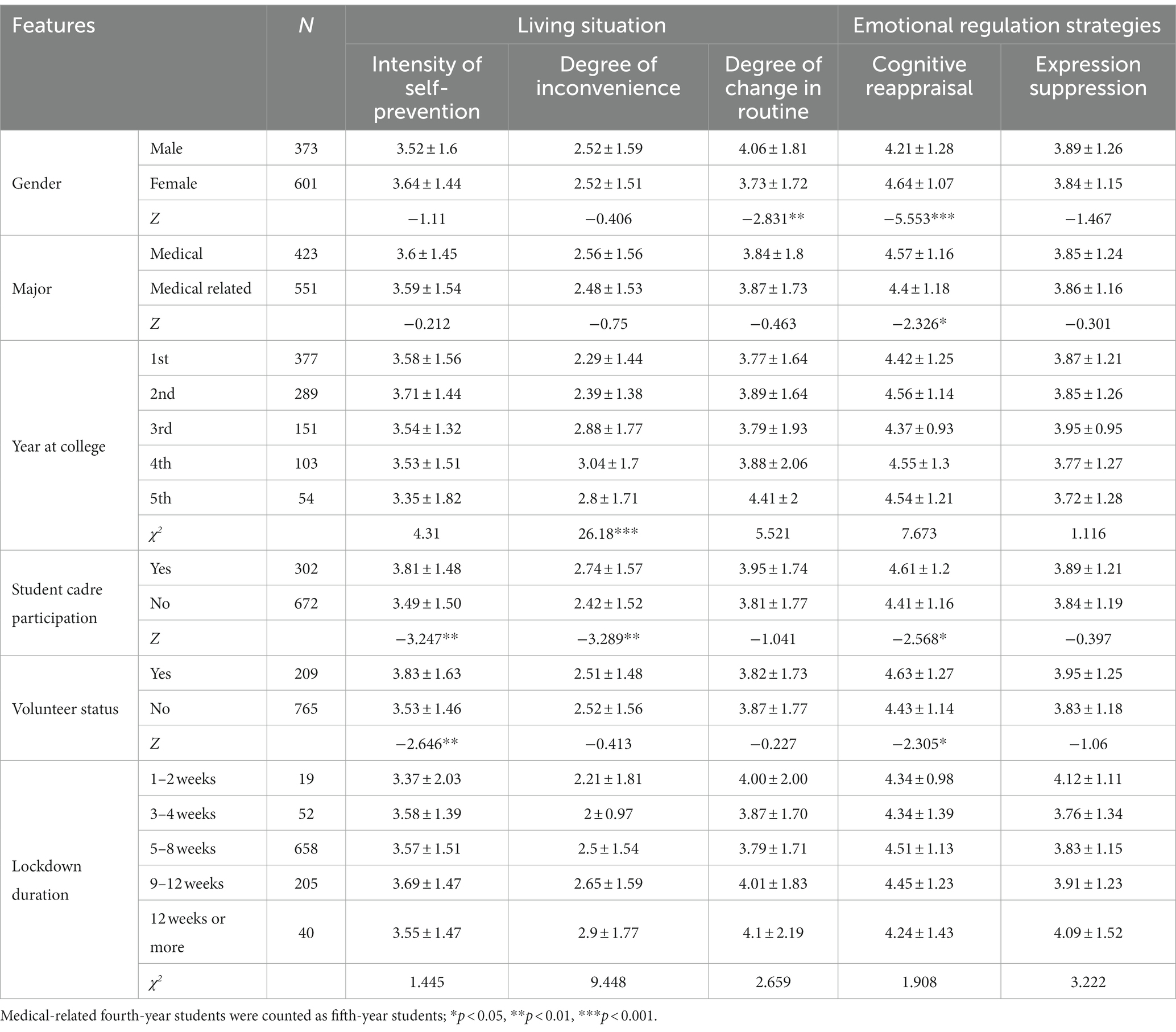
Table 1. Medical school students’ living conditions, emotion regulation strategy scores under campus lockdowns (N = 974).
3.2.2. Descriptive statistics for mental health
The mean total PQEEPH score during the campus lockdowns was 3.66 ± 3.06, and the mean scores of each dimension from highest to lowest were fear (1 ± 0.62), depression (0.89 ± 0.8), neurosis (0.84 ± 0.74), obsessive–compulsive-anxiety (0.48 ± 0.64), and hypochondriasis (0.45 ± 0.64). In addition, univariate analysis showed statistically significant differences in depression scores based on lockdown duration (χ2 = 11.4, p < 0.05); neurosis scores based on major, year at college, volunteer status, and lockdown duration (Z/χ2 = −2.612, 19.771, −2.636, 11.938, ps < 0.05); fear scores based on gender, year at college, and lockdown duration (Z/χ2 = −2.866, 10.922, 13.133, ps < 0.05); obsessive–compulsive-anxiety scores based on year at college and lockdown duration (χ2 = 13.034, 17.231, ps < 0.05); and hypochondriasis scores based on lockdown duration (χ2 = 21.133, p < 0.05; Table 2).
3.3. Factors influencing mental health during campus lockdown management
Spearman’s correlation analysis showed that the degree of inconvenience and change in routine, cognitive reappraisal, expression suppression, and the five PQEEPH dimensions were significantly correlated (r = −0.114 ~ 0.387, ps < 0.05), except for cognitive reappraisal, which was not significantly associated with fear. The intensity of self-prevention was only significantly correlated with fear (r = 0.096, p < 0.01).
The scores of the five PQEEPH dimensions were used as dependent variables. The variables that were meaningful for each dimension of univariate analysis, such as gender, major, year at college, volunteer status (coded in the same way as 2.2), lockdown duration (1–2 weeks, 3–4 weeks, 5–8 weeks, 9–12 weeks, and more than 12 weeks were coded as 0–4, respectively), and the scores of each scale were used as independent variables for further multiple linear stepwise regression analysis. The results showed that depression (R2 = 0.326, F = 93.664, p < 0.001), neurosis (R2 = 0.291, F = 49.431, p < 0.001), fear (R2 = 0.184, F = 31.106, p < 0.001), obsessive–compulsive-anxiety (R2 = 0.27, F = 44.583, p < 0.001), and hypochondriasis (R2 = 0.164, F = 23.621, p < 0.001) were significant for all five-dimensional regression model effects. Consistent with Hypotheses 1, 2, and 3, degree of change in routine, degree of inconvenience, and expression suppression were significant positive predictors of all five psychological response dimensions, and cognitive reappraisal was a significant negative predictor of four dimensions, excluding fear. Being under campus lockdown for 3–12 weeks was a significant negative predictor of obsessive–compulsive anxiety and hypochondriasis, 5–8 weeks was a significant negative predictor of depression and fear, with 12 weeks or more being a significant positive predictor of neurosis, fear, and a significant negative predictor of hypochondriasis. Being in the third year of study significantly positively predicted neurosis, fear, and obsessive–compulsive anxiety. Neurosis was significantly positively predicted by having a medical-related major and significantly negatively predicted by not being a volunteer. Female gender significantly positively predicted fear (Table 3).
3.4. Testing of the mediated model of medical school students’ mental health
To further explore the role of emotion regulation strategies in the relationship between medical school students’ campus living conditions and mental health, the survey data were analyzed and processed according to the mediating effect test procedure proposed by Wen and Ye (42). The degrees of change in routine and inconvenience were taken as independent variables X1 and X2, respectively. Cognitive reappraisal was mediating variable M1, and expression suppression was mediating variable M2. The total PQEEPH score was dependent variable Y. Model 6 was used to perform mediation analysis, with lockdown duration, year at college, major, volunteer status, and gender as covariates, which were standardized for each variable (Table 4).
Significance analysis of the mediating effects was performed using the bias-corrected percentile bootstrap method (repeated sampling 5,000 times, 95% confidence interval [CI]). The results showed that after controlling for the mediating variables (cognitive reappraisal and expression suppression), the direct effect of the degree of inconvenience on the dependent variable (mental health) was significant, with an interval that did not contain 0 (effect = 0.683, 95% CI: [0.569, 0.798]). In addition, the direct impact of the degree of change in routine on the dependent variable (mental health) was also significant, with an interval that did not contain 0 (effect = 0.69, SE = 0.493, 95% CI: [0.594, 0.787]).
Consistent with Hypothesis 4, the chain mediating effects of cognitive reappraisal and expression suppression were all significant. Degree of inconvenience significantly affected mental health through three paths: ① degree of inconvenience → cognitive reappraisal → mental health (effect = 0.031, SE = 0.018, 95% CI: [0.006, 0.064]), ② degree of inconvenience → expression suppression → mental health (effect = 0.056, SE = 0.018, 95% CI: [0.023, 0.092]), and ③ degree of inconvenience → cognitive reappraisal → expression suppression → mental health (effect = −0.022, SE = 0.01, 95% CI: [−0.042, −0.005]). The mediating effects of paths ① and ② were significant and accounted for 12.73% of the direct effect. The masking effect of path ③ was significant and accounted for 3.23% of the direct effect. The results are shown in Table 5, and the specific paths are shown in Figure 2.
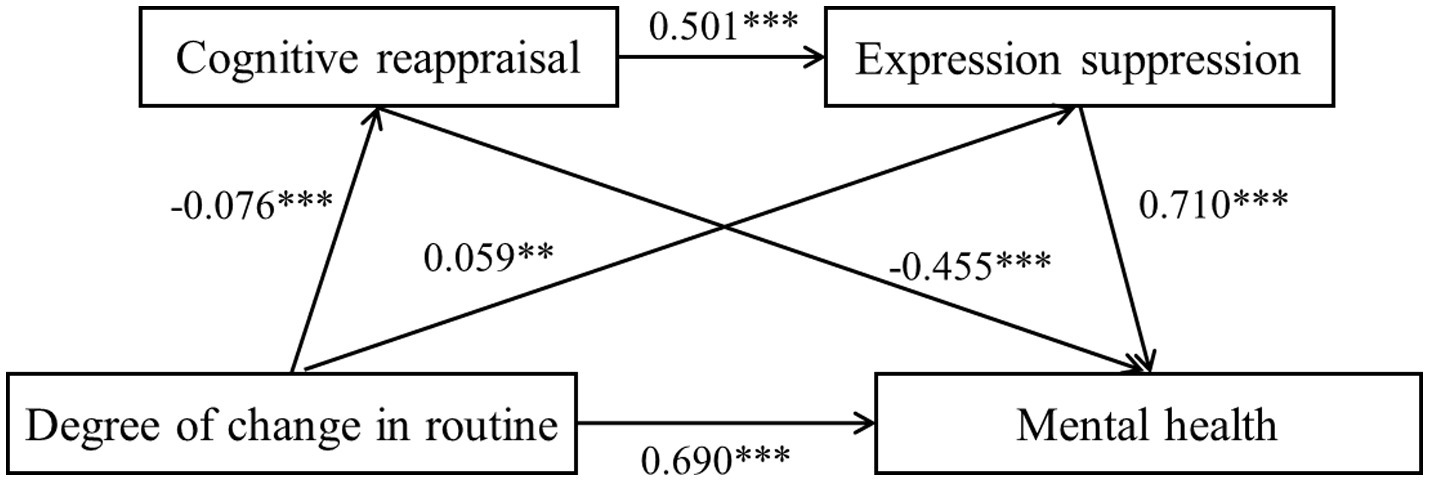
Figure 2. Pathway diagram of the chain mediating effect of “degree of inconvenience – mental health.”
The degree of change in routine also significantly affected mental health through three paths: ④ degree of change in routine → cognitive reappraisal → mental health (effect = 0.035, SE = 0.015, 95% CI: [0.011, 0.064]), ⑤ degree of change in routine → expression suppression → mental health (effect = 0.042, SE = 0.018, 95% CI: [0.013, 0.075]), and ⑥ degree of change in routine → cognitive reappraisal → expression suppression → mental health (effect = −0.027, SE = 0.01, 95% CI: [−0.046, −0.01]). The mediating effect of paths ④ and ⑤ was significant and accounted for 11.11% of the direct effect. The masking effect of path ⑥ was significant and accounted for 3.93% of the direct effect. The results are shown in Table 5, and the specific paths are shown in Figure 3.
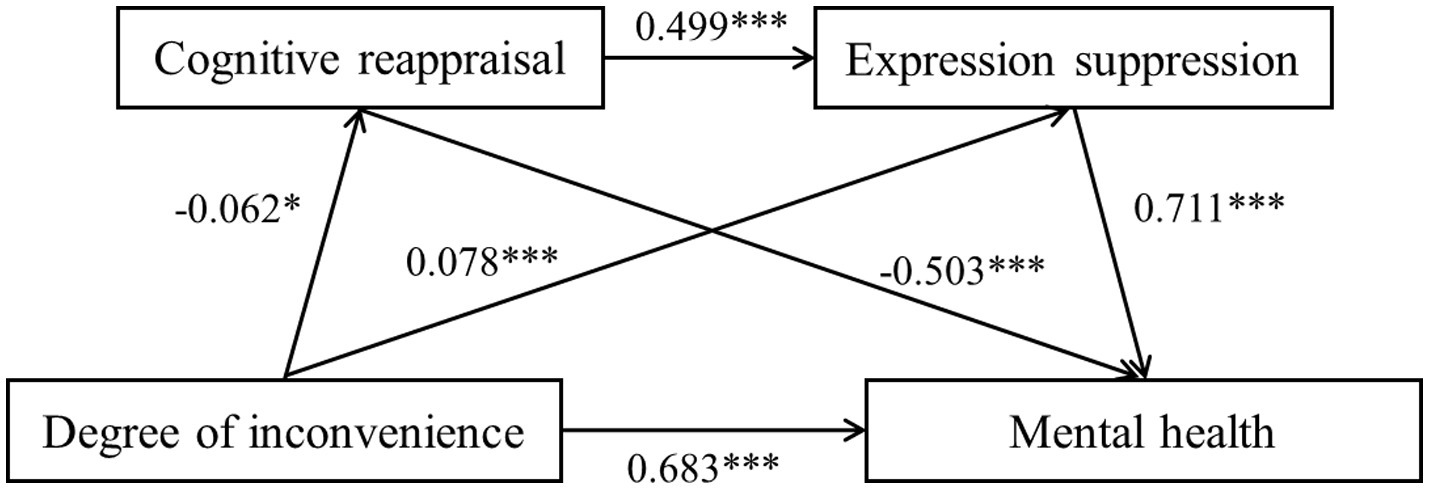
Figure 3. Pathway diagram of the chain mediating effect of “degree of change in routine – mental health.”
4. Discussion
This study examined the role of campus lockdown management on medical school students’ mental health during the COVID-19 pandemic. The results showed that living conditions could directly affect mental health, and cognitive reappraisal and expression suppression played partial mediating and partial chain mediating roles in that relationship.
4.1. Objective factors affecting medical school students’ mental health
Campus lockdown duration, year at college, major, volunteer status, gender, and other objective factors have a specific impact on mental health. Campus lockdowns for “1–2 weeks” and “3 months and more” led to a high incidence of psychological reactions in students. Third-year students reported more neurosis, fear, and obsessive–compulsive anxiety than other students, while female students had a stronger fear reaction than male students. An additional explanation of the self-report questionnaire showed that the main reasons for students’ psychological reactions during the “1–2 weeks” lockdown were changes in the rhythm of campus life and fear of the virus, which gradually subsided after 2 weeks. With the continuous extension of lockdowns, students could not foresee a return to normal life, which exacerbated their adverse psychological responses.
Although the third-year students had started their clinical internships, the COVID-19 pandemic campus lockdown interrupted them. Thus, the students felt that the pandemic strongly affected their studies, which is consistent with the findings of Wang et al. (43). The study also showed that female students had a more pronounced fear response than males, which is consistent with the findings of Xu and Huang (44) and Metin et al. (45) – fear can lead to worse mental health outcomes: female students were more likely to show “easy-to-acquire, hard-to-abate” characteristics concerning memories of fear, owing to their physiology and estrogen levels. This finding suggests that more attention needs to be paid to students’ psychological reactions during the initial period of campus lockdowns and for lockdowns that last 3 months or more. Therefore, colleges should implement measures, such as helping students resolve their worries, relieve stress, overcome fears, and improve their coping efficacy related to the pandemic, through mental health education and knowledge dissemination on pandemic prevention and control (46). Furthermore, colleges should also organize students to participate in campus pandemic prevention and control propaganda and volunteer services, organize non-group outdoor activities to enrich students’ campus lives, and offer services such as distance learning, virtual simulation teaching, and clinical skills training to reduce the pandemic’s impact on third-year students’ internships.
4.2. Living conditions affecting medical school students’ mental health
Although previous studies (12–16) have focused on objective factors, such as lockdown duration and location, they have neglected to examine subjective factors. To address this gap, this study measured subjective factors related to lockdowns. The preliminary results showed that subjective characteristics, such as perceived changes in routine and inconvenience in daily life, significantly affected mental health during lockdowns, compared with objective factors such as lockdown duration and volunteer status. This suggests that colleges should focus on students who have been under extended lockdown and non-volunteers to identify people with poor mental health and should also consider students’ personal feelings during the campus lockdown process. Furthermore, this strategy would contribute to identifying and responding effectively to students’ psychological problems during campus lockdown management.
Students’ subjective perceptions of daily life inconveniences and routine changes during campus lockdowns were closely related to their mental health. The higher the degree of inconvenience and change in daily routine, the higher the scores on the five psychological reaction dimensions and the poorer the mental health outcomes. During campus lockdowns, students are restricted to the campus. Changes in their routines, a narrowed scope of life and study activities, and inconveniences in daily life increase the possibility of students developing psychological problems. Various types of support and recreational facilities should be provided during campus lockdown to enrich campus life and provide students with the necessary psychological support. This could guide students toward adopting positive emotional regulation strategies and channels for discussing worries and relieving negative emotions, thereby providing them with appropriate psychoeducation on controlling their frustration. These prudent measures could effectively promote the mental health development of medical school students.
4.3. Mediating role of emotion regulation between living conditions and mental health
Cognitive reappraisal modulates emotions before they occur and alters emotional reactions, experiences, and unpleasant moods, significantly reducing the risk of emotional distress and other mental health problems. Conversely, expression suppression strategies targeting emotions, such as depression, obsessions, and neurosis, within an individual worsen emotional problems. When the degree of inconvenience was the independent variable, it significantly negatively predicted cognitive reappraisal and significantly positively predicted expression suppression. Furthermore, cognitive reappraisal significantly positively predicted expression suppression. When the degrees of inconvenience, cognitive reappraisal, and expression suppression were entered into the regression equation simultaneously, they all positively predicted mental health, indicating that cognitive reappraisal and expression suppression partially mediated the degree of inconvenience and mental health, respectively.
By contrast, cognitive reappraisal and expression suppression mediated the chain effect between them. The same was true when the independent variable was the degree of change in routine. This result shows that cognitive reappraisal and emotion regulation strategies (particularly those involving expression suppression) mediate between campus lockdown living conditions and mental health. Subjective experiences, such as inconvenience in daily life and changes in routine related to campus lockdowns, may reduce the use of cognitive reappraisal, thereby threatening mental health. However, feelings of helplessness regarding the current situation may further increase the use of expression suppression and intensify psychological reactions. Thus, cognitive reappraisal is conducive to reducing adverse psychological reactions, while expression suppression elicits the opposite. This finding is generally consistent with Xu et al. (47) and Akbari et al. (48) regarding the mediating role of different emotion regulation strategies between external stimuli and psychological reactions.
Notably, using cognitive reappraisal before the onset of emotions and expression suppression during the onset of emotions can reduce psychological reactions to some extent in the context of campus lockdowns; this complements Gross’s classical emotion regulation strategy theory (24, 25) on the roles of both strategies. This study’s findings show that the integrated use of both emotion regulation strategies is an effective method for improving mental health during campus lockdown management, which provides new ideas for active prevention of, and intervention against college students’ mental health problems.
5. Limitations and future research
This study was based on data obtained during the most stringent campus lockdown period of the pandemic. With the introduction of new policies to control the pandemic in China, this strict closure environment may be challenging to recreate. In addition, this study was mainly based on quantitative research and lacks qualitative research, although the subjective and objective factors of campus lockdown were considered as much as possible. In-depth interviews with relevant stakeholders, such as administrators, teachers, and students, should be more prominent in future studies. Finally, the context of Anhui Province is very different from other provinces, regions, and countries. Further comparison of data from different contexts to identify similarities and differences is necessary for future studies.
6. Conclusion
The results of this study show that emotion regulation is a potential mediating mechanism in the relationship between the degree of inconvenience, the degree of change in routine, and mental health. In addition, cognitive reappraisal and expression suppression have a partial mediation effect between the degree of inconvenience and mental health and the degree of change in routine and mental health.
Data availability statement
The raw data supporting the conclusions of this article will be made available by the authors, without undue reservation.
Ethics statement
The studies involving human participants were reviewed and approved by the Medical Ethics Committee of Wannan Medical College. The patients/participants provided their written informed consent to participate in this study.
Author contributions
WZ contributed to the conception and design of the study, and wrote the first draft of manuscript. LH and FX wrote sections of the manuscript. All authors contributed to the manuscript revision and have read and approved the submitted version.
Funding
This study was supported by the Major Project of Humanities and Social Sciences of the Anhui Provincial Education Department (Grant No. SK2019ZD19), the National College Students’ Innovation and Entrepreneurship Training Program of China (Grant No. 202210368026) and the Special Project on Ideological and Political Education for Counselors of Wannan Medical College (Grant No. SZ201902).
Acknowledgments
We would like to thank Wannan Medical College for data support and Editage (www.editage.cn) for English language editing.
Conflict of interest
The authors declare that the research was conducted in the absence of any commercial or financial relationships that could be construed as a potential conflict of interest.
Publisher’s note
All claims expressed in this article are solely those of the authors and do not necessarily represent those of their affiliated organizations, or those of the publisher, the editors and the reviewers. Any product that may be evaluated in this article, or claim that may be made by its manufacturer, is not guaranteed or endorsed by the publisher.
Supplementary material
The Supplementary material for this article can be found online at: https://www.frontiersin.org/articles/10.3389/fpsyt.2023.1171425/full#supplementary-material
Footnotes
References
1. World Health Organization. Statement on the second meeting of the international health regulations (2005) emergency committee regarding the outbreak of novel coronavirus (2019-nCoV). (2019). Available at: https://www.who.int/news/item/30-01-2020-statement-on-the-second-meeting-of-the-international-health-regulations-(2005)-emergency-committee-regarding-the-outbreak-of-novel-coronavirus-(2019-ncov) (Accessed February 10, 2023).
2. United Nations Educational, Scientific and Cultural Organization. What’s next? Lessons on education recovery: findings from a survey of ministries of education amid the COVID-19 pandemic. (2021). Available at: http://uis.unesco.org/en/news/whats-next-lessons-education-recovery (Accessed April 20, 2023).
3. Hurwitz, ER, and Krumhansl, CL. Shifting listening niches: effects of the COVID-19 pandemic. Front Psychol. (2021) 12:648413. doi: 10.3389/fpsyg.2021.648413
4. The State Council of the People’s Republic of China. Regular measures taken to control epidemic. (2020). Available at: http://english.www.gov.cn/premier/news/202004/06/content_WS5e8b337dc6d0c201c2cc0451.html (Accessed April 20, 2023).
5. Zhang, L, Cheng, X, and Li, Z. How perceived risk influences college students’ preventive behavior: novel data of COVID-19 campus lockdown from Wuhan, China. Front Public Health. (2023) 11:1029049. doi: 10.3389/fpubh.2023.1029049
6. Liu, TH, Xia, Y, and Ma, Z. Multifarious linkages between personality traits and psychological distress during and after COVID-19 campus lockdown: a psychological network analysis. Front Psych. (2022) 13:816298. doi: 10.3389/fpsyt.2022.816298
7. Xu, H, Wang, Z, Peng, L, Mi, Y, Zeng, P, and Liu, X. The study of psychological traits among Chinese college students during the COVID-19 campus lockdown. Front Psychol. (2022) 13:1051770. doi: 10.3389/fpsyg.2022.1051770
8. Liu, X, Peng, L, Wang, Z, Zeng, P, Mi, Y, and Xu, H. Effects of interpersonal sensitivity on depressive symptoms in postgraduate students during the COVID-19 pandemic: psychological capital and sleep quality as mediators. Front Psych. (2023) 14:1100355. doi: 10.3389/fpsyt.2023.1100355
9. Wang, W, Wang, J, Zhang, X, Pei, Y, Tang, J, Zhu, Y, et al. Network connectivity between anxiety, depressive symptoms and psychological capital in Chinese university students during the COVID-19 campus closure. J Affect Disord. (2023) 329:11–8. doi: 10.1016/j.jad.2023.02.087
10. Zhang, X, Liu, X, Mi, Y, Wang, W, and Xu, H. Resilience and depressive symptoms mediated pathways from social support to suicidal ideation among undergraduates during the COVID-19 campus lockdown in China. Psychol Res Behav Manag. (2022) 15:2291–301. doi: 10.2147/PRBM.S377158
11. Zhang, B, Lei, SM, Le, S, Gong, Q, Cheng, S, and Wang, X. Changes in health behaviors and conditions during COVID-19 pandemic strict campus lockdown among Chinese university students. Front Psychol. (2022) 13:1022966. doi: 10.3389/fpsyg.2022.10229666
12. Wang, Z, Jiang, B, Wang, X, Niu, Y, and Xue, H. Cross-sectional investigation and correlation analysis of psychology of college students returning to campus after COVID-19 lockdown lift. Front Psych. (2022) 13:915042. doi: 10.3389/fpsyt.2022.915042
13. Cao, L. The relationship between adjustment and mental health of Chinese freshmen: the mediating effect of security and the moderating effect of gender. Front Public Health. (2022) 10:916329. doi: 10.3389/fpubh.2022.916329
14. Xiang, YT, Yang, Y, Li, W, Zhang, L, Zhang, Q, Cheung, T, et al. Timely mental health care for the 2019 novel coronavirus outbreak is urgently needed. Lancet Psychiatry. (2020) 7:228–9. doi: 10.1016/s2215-0366(20)30046-8
15. Pinedo, R, Vicario-Molina, I, González Ortega, E, and Palacios, PA. Factors related to mental health during the COVID-19 lockdown in Spain. Front Psychol. (2021) 12:715792. doi: 10.3389/fpsyg.2021.715792
16. Thibaut, F, and van Wijngaarden-Cremers, PJM. Women’s mental health in the time of Covid-19 pandemic. Front Glob Womens Health. (2020) 1:588372. doi: 10.3389/fgwh.2020.588372
17. Gloster, AT, Lamnisos, D, Lubenko, J, Presti, G, Squatrito, V, Constantinou, M, et al. Impact of COVID-19 pandemic on mental health: an international study. PLoS One. (2020) 15:e0244809. doi: 10.1371/journal.pone.0244809
18. Sánchez-Guarnido, AJ, Lucena, V, Torrent, A, Bosa, L, Martinez-López, V, Cuartiles-Berenguer, A, et al. Mental health day hospitals and lockdown due to COVID-19 in Spain. Front Psychol. (2022) 13:769015. doi: 10.3389/fpsyg.2022.769015
19. Smith, HJ, Pettigrew, TF, Pippin, GM, and Bialosiewicz, S. Relative deprivation: a theoretical and meta-analytic review. Personal Soc Psychol Rev. (2012) 16:203–32. doi: 10.1177/1088868311430825
20. Qingsen, HE, Lingxia, L, and Xiaocai, G. Mental health status and influencing factors of undergraduate nursing students under the epidemic of COVID-19. China J Health Psychol. (2021) 29:691–5. doi: 10.13342/j.cnki.cjhp.2021.05.01136
21. Tian, F, Li, HX, Tian, SC, Yang, J, Shao, J, and Tian, C. Psychological symptoms of ordinary Chinese citizens based on SCL-90 during the level I emergency response to COVID-19. Psychiatry Res. (2020) 288:112992. doi: 10.1016/j.psychres.2020.112992
22. Byrnes, YM, Civantos, AM, Go, BC, McWilliams, TL, and Rajasekaran, K. Effect of the COVID-19 pandemic on medical student career perceptions: a national survey study. Med Educ Online. (2020) 25:1798088. doi: 10.1080/10872981.2020.1798088
23. Chadi, N, Ryan, NC, and Geoffroy, MC. COVID-19 and the impacts on youth mental health: emerging evidence from longitudinal studies. Can J Public Health. (2022) 113:44–52. doi: 10.17269/s41997-021-00567-8
24. Gross, JJ. The emerging field of emotion regulation: an integrative review. Rev Gen Psychol. (1998) 2:271–99. doi: 10.1037/1089-2680.2.3.271
25. Gross, JJ, and John, OP. Individual differences in two emotion regulation processes: implications for affect, relationships, and well-being. J Pers Soc Psychol. (2003) 85:348–62. doi: 10.1037/0022-3514.85.2.348
26. Willner, CJ, Hoffmann, JD, Bailey, CS, Harrison, AP, Garcia, B, Ng, ZJ, et al. The development of cognitive reappraisal from early childhood through adolescence: a systematic review and methodological recommendations. Front Psychol. (2022) 13:875964. doi: 10.3389/fpsyg.2022.875964
27. Hassa, T, Spiteri, S, Schmidt, R, Merkel, C, and Schoenfeld, MA. Increased amygdala activity associated with cognitive reappraisal strategy in functional neurologic disorder. Front Psych. (2021) 12:613156. doi: 10.3389/fpsyt.2021.613156
28. Yan, C, Ding, Q, Wang, Y, Wu, M, Gao, T, and Liu, X. The effect of cognitive reappraisal and expression suppression on sadness and the recognition of sad scenes: an event-related potential study. Front Psychol. (2022) 13:935007. doi: 10.3389/fpsyg.2022.935007
29. Yuan, J, Li, L, and Tian, Y. Automatic suppression reduces anxiety-related overestimation of time perception. Front Physiol. (2020) 11:537778. doi: 10.3389/fphys.2020.537778
30. Enav, Y, Hardan, AY, and Gross, JJ. Cognitive reappraisal training for parents of children with autism spectrum disorder. Front Psych. (2022) 13:995669. doi: 10.3389/fpsyt.2022.995669
31. Shigematsu, J, and Kobayashi, R. Relationship between emotion regulation strategies and total conviction in promoting behavior change. Front Psychol. (2022) 13:941404. doi: 10.3389/fpsyg.2022.941404
32. Xu, C, Xu, Y, Xu, S, Zhang, Q, Liu, X, Shao, Y, et al. Cognitive reappraisal and the association between perceived stress and anxiety symptoms in COVID-19 isolated people. Front Psych. (2020) 11:858. doi: 10.3389/fpsyt.2020.00858
33. Katana, M, Röcke, C, Spain, SM, and Allemand, M. Emotion regulation, subjective well-being, and perceived stress in daily life of geriatric nurses. Front Psychol. (2019) 10:1097. doi: 10.3389/fpsyg.2019.01097
34. Sai, L, Luo, S, Ward, A, and Sang, B. Development of the tendency to use emotion regulation strategies and their relation to depressive symptoms in Chinese adolescents. Front Psychol. (2016) 7:1222. doi: 10.3389/fpsyg.2016.01222
35. Bureau of Disease Control and Prevention. State council response to the new coronavirus pneumonia outbreak joint prevention and joint control mechanism integrated group. Notice on the issuance of the novel coronavirus pneumonia prevention and control program (2021-5-11). 8th ed. (Joint Prevention and Control Mechanism Integrated Issue [2021] No. 51). (2021) Available at: http://www.nhc.gov.cn/jkj/s3577/202105/6f1e8ec6c4a540d99fafef52fc86d0f8.shtml
36. Xie, DD, Yang, Y, and Cheng, LJ. The impact of home quarantine and physical exercise on mental health during COVID-19. Chinese J Clin Psychol. (2021) 29:1343–7. doi: 10.16128/j.cnki.1005-3611.2021.06.045
37. Gross, JJ. Emotion regulation: affective, cognitive, and social consequences. Psychophysiology. (2002) 39:281–91. doi: 10.1017/s0048577201393198
38. Zhang, L, Wang, S, Shen, J, Wang, Y, Huang, X, Wu, F, et al. The mental health of Chinese healthcare staff in non-epicenter of COVID-19: a cross-sectional study. Ann Palliat Med. (2020) 9:4127–36. doi: 10.21037/apm-20-2041
39. Preacher, KJ, and Hayes, AF. SPSS and SAS procedures for estimating indirect effects in simple mediation models. Behav Res Methods Instrum Comput. (2004) 36:717–31. doi: 10.3758/bf03206553
40. Hayes, AF. Introduction to mediation, moderation, and conditional process analysis: a regression-based approach. New York: The Guilford Press (2013).
41. Podsakoff, PM, MacKenzie, SB, Lee, JY, and Podsakoff, NP. Common method biases in behavioral research: a critical review of the literature and recommended remedies. J Appl Psychol. (2003) 88:879–903. doi: 10.1037/0021-9010.88.5.879
42. Wen, Z, and Ye, B. Analyses of mediating effects: the development of methods and models. Adv Psychol Sci. (2014) 22:731–45. doi: 10.3724/SP.J.1042.2014.00731
43. Wang, C, Pan, R, Wan, X, Tan, Y, Xu, L, McIntyre, RS, et al. A longitudinal study on the mental health of general population during the COVID-19 epidemic in China. Brain Behav Immun. (2020) 87:40–8. doi: 10.1016/j.bbi.2020.04.028
44. Xu, F, and Huang, L. Impacts of stress response and negative emotion on mental health of college students during the COVID-19 outbreak. Front Psych. (2022) 12:784661. doi: 10.3389/fpsyt.2021.784661
45. Metin, A, Erbiçer, ES, Şen, S, and Çetinkaya, A. Gender and COVID-19 related fear and anxiety: a meta-analysis. J Affect Disord. (2022) 310:384–95. doi: 10.1016/j.jad.2022.05.036
46. Xu, F, and Huang, L. Impacts of stress and risk perception on mental health of college students during the COVID-19 pandemic: the mediating role of coping efficacy. Front Psych. (2022) 12:767189. doi: 10.3389/fpsyt.2021.767189
47. Xu, Y, Zhang, X, and Yang, J. Mediating role of emotional regulation strategy in the influence of social support on mental health of overseas students in China during COVID-19 epidemic. China J Health Psychol. (2022) 30:452–7. doi: 10.13342/j.cnki.cjhp.2022.03.027
48. Akbari, M, Spada, MM, Nikčević, AV, and Zamani, E. The relationship between fear of COVID-19 and health anxiety among families with COVID-19 infected: the mediating role of metacognitions, intolerance of uncertainty and emotion regulation. Clin Psychol Psychother. (2021) 28:1354–66. doi: 10.1002/cpp.2628
Keywords: COVID-19 pandemic, campus lockdown, medical school students, emotion regulation strategies, mental health
Citation: Zhang W, Huang L, Xu F, Liu H and Wang G (2023) Impact of campus living conditions on Chinese medical school students’ mental health during the COVID-19 campus lockdown: the chain mediating role of cognitive reappraisal and expression suppression. Front. Psychiatry. 14:1171425. doi: 10.3389/fpsyt.2023.1171425
Edited by:
Shen Liu, Anhui Agricultural University, ChinaReviewed by:
Haibo Xu, Xuzhou Medical University, ChinaRuichen Jiang, Shanghai University of Sport, China
Copyright © 2023 Zhang, Huang, Xu, Liu and Wang. This is an open-access article distributed under the terms of the Creative Commons Attribution License (CC BY). The use, distribution or reproduction in other forums is permitted, provided the original author(s) and the copyright owner(s) are credited and that the original publication in this journal is cited, in accordance with accepted academic practice. No use, distribution or reproduction is permitted which does not comply with these terms.
*Correspondence: Guoping Wang, MTk5NTAwMDlAd25tYy5lZHUuY24=; Hairong Liu, bGhyQHdubWMuZWR1LmNu
 Wei Zhang
Wei Zhang Long Huang
Long Huang Fengyun Xu
Fengyun Xu Hairong Liu2,3*
Hairong Liu2,3*